Centauri Dreams
Imagining and Planning Interstellar Exploration
M-Dwarf Planets: ExTrA and TRAPPIST-1
A new project called Exoplanets in Transits and their Atmospheres (ExTrA) has been set in motion at the European Southern Observatory’s site at La Silla (Chile). Funded by the European Research Council and the French Agence National de la Recherche, ExTrA’s three 0.6-metre telescopes will be operated remotely from Grenoble, France. This is an exoplanet transit effort centered around finding and characterizing Earth-sized planets orbiting M-dwarf stars.
Not an easy task from the ground, as lead researcher Xavier Bonfils makes clear, though if you’re going to attempt it, northern Chile offers optimum conditions:
“La Silla was selected as the home of the telescopes because of the site’s excellent atmospheric conditions. The kind of light we are observing — near-infrared — is very easily absorbed by Earth’s atmosphere, so we required the driest and darkest conditions possible. La Silla is a perfect match to our specifications.”
To do its work, ExTrA weds spectroscopic information to traditional photometry. The collected light from the target star is fed through optical fibres into a multi-object spectrograph. Known as differential photometry, the method involves collecting light not only from the target but also from four comparison stars. The comparison helps the technology filter out atmospheric distortions and effects produced by the instruments and detectors themselves.
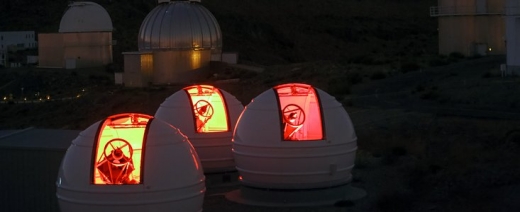
Image: A new national facility at ESO’s La Silla Observatory has successfully made its first observations. The ExTrA telescopes will search for and study Earth-sized planets orbiting nearby red dwarf stars. ExTrA’s novel design allows for much improved sensitivity compared to previous searches. Astronomers now have a powerful new tool to help in the search for potentially habitable worlds. Credit: ESO.
Bonfils adds:
“With the next generation of telescopes, such as ESO’s Extremely Large Telescope, we may be able to study the atmospheres of exoplanets found by ExTra to try to assess the viability of these worlds to support life as we know it. The study of exoplanets is bringing what was once science fiction into the world of science fact.”
Thus ground-based observation continues to increase in precision, soon to be supplemented by space missions like the Transiting Exoplanet Survey Satellite (TESS), the James Webb Space Telescope (JWST) and the European CHaracterising ExOPlanet Satellite (CHEOPS).
Close Look at TRAPPIST-1
And while we’re talking about M-dwarfs, a new paper is out looking at one of the most interesting systems yet discovered, comprising the seven planets around TRAPPIST-1. Lead author Amy Barr (Planetary Science Institute) and colleagues go to work on the interior structures of these planets as well as their tidal heating and convection given what we know about their mass and radius. The balance between tidal heating and convective transport has implications for the mantles of each planet.
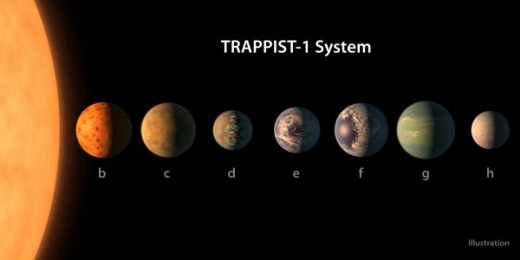
Image: A size comparison of the planets of the TRAPPIST-1 system, lined up in order of increasing distance from their host star. The planetary surfaces are portrayed with an artist’s impression of their potential surface features, including water, ice, and atmospheres. The paper from Amy Barr, Vera Dobos and László L. Kiss shows that planets d and e are the most likely to be habitable due to their moderate surface temperatures, modest amounts of tidal heating, and because their heat fluxes are low enough to avoid entering a runaway greenhouse state. Planet d is likely covered by a global water ocean. Credit: NASA/R. Hurt/T. Pyle.
Given that their orbits are slightly eccentric, there is the possibility of tidal heating, which in the Galilean moons has intrigued us for its possibilities at providing an energy source for life beneath an icy crust, and indeed, the paper notes that “…on planets b, e, f, g and h, life might appear in the tidally heated (subsurface) ocean close to hydrothermal vents.“
In the TRAPPIST-1 system, though, we have much to learn about the composition of the respective worlds. The Barr paper examines the limits of present knowledge:
Assuming the planets are composed of water ice, rock, and iron, we determine how much of each might be present, and how thick the different layers would be. Because the masses and radii of the planets are not very well-constrained, we show the full range of possible interior structures and interior compositions.
The paper is a thoroughgoing examination of the TRAPPIST-1 planets, with planets d and e flagged as the most likely to produce habitable conditions. Here tidal heating would be modest and heat flux low enough to avoid runaway greenhouse conditions:
Planet d is likely to be covered by a global water ocean, and can be habitable if its albedo is ? 0.3. Planetary albedos may be estimated from photometric measurements during occultations (see e.g. Rowe et al., 2008) which may give an additional constraint on the habitability of TRAPPIST-1d. As discussed in Section 5, planet e is likely to have liquid water on its surface, too, according to climate models (Turbet et al., 2017; Wolf, 2017).
Planets f, g, and h, the authors believe, are rich in H2O, possibly containing liquid water oceans beneath a thick ice mantle. Planets b and c likely harbor magma oceans in their interiors. Planet b in particular demands further work, given its proximity to the central star and its “seemingly water-rich composition,” while c may experience eruptions from its magma ocean, a phenomenon that may eventually become detectable.
But note how far we have to go:
Our knowledge of the compositions of the four interior planets, chiefly, their water content, can significantly be improved if their masses can be determined to within ? 0.1 to 0.5M?, which will require further observations of the TRAPPIST-1 system.
The paper is Barr et al., “Interior Structures and Tidal Heating in the TRAPPIST-1 Planets,” accepted at Astronomy & Astrophysics (preprint).

Defining a Brown Dwarf / Planet Boundary
A paper that crossed my desk this morning proves timely in light of our recent discussions about brown dwarfs. Specifically, the question of when to declare an object a planet or a brown dwarf has come up, with the cutoff often cited at about 13 Jupiter masses. Now I see that Johns Hopkins’ Kevin Schlaufman is proposing a cutoff somewhere closer to 10 Jupiter masses, but the idea takes us beyond mass as the determinant of the object’s status.

We tend to turn toward the IAU Working Group on Extrasolar Planets for our ideas on the planet/brown dwarf distinction, though the fact that we can find objects with 10 times Jupiter’s mass both in orbit around stars and also in isolation makes the definition a challenging one. The IAU has defined a planet as an object with a mass below the limiting mass for deuterium fusion that orbits a star or stellar remnant. Objects above this limiting mass have been defined as brown dwarfs, no matter how they formed or where they are located. This is where the 13 Jupiter mass cutoff comes from, although other models have also been proposed.
Image: Johns Hopkins astrophysicist Kevin Schlaufman has proposed a new definition of a planet. Credit: Johns Hopkins University.
But this gets tricky, because much depends on composition — the mass needed for deuterium fusion depends on the object. Under this definition, a metal-poor object of 13 Jupiter masses would be considered a planet, while a metal-rich object of the same mass would be considered a brown dwarf. Nor does this definition take into account formation models.
Schlaufman has made a close study of some 146 planetary systems in his efforts to distinguish between huge planets and tiny brown dwarfs. As the paper says:
This combined sample of 146 giant planets, brown dwarfs, and low-mass stars that have Doppler-inferred masses and transit solar-type primaries (most with homogeneously derived stellar parameters) is the best sample available to calculate the mass at which low-mass secondary companions no longer preferentially orbit metal-rich solar-type primaries.
Mass, in Schlaufman’s view, is simply not enough of a determinant when making the call between planet and brown dwarf. Instead, he proposes looking at the chemical composition of host stars. Giant planets will be found orbiting stars with high metallicity because planets like Jupiter form by building up a rocky core that is later enveloped by a gaseous envelope — this is core accretion. Gas giants are invariably found orbiting dwarf stars that are rich in metals.
Brown dwarfs and stars, on the other hand, form from the top down, clouds of gas collapsing to produce the object through the model referred to as gravitational instability. And indeed, we don’t see brown dwarfs necessarily associated with stars with high metal content. In Schlaufman’s study, objects more massive than 10 times Jupiter mass can be found near stars with varying degrees of metal content. The lack of correlation tells the tale.
Thus the paper:
Celestial bodies with M ? 10 MJup preferentially orbit metal-rich solar-type dwarf stars, while celestial bodies with M ? 10 MJup do not preferentially orbit metal-rich solar-type dwarf stars. A preference for metal-rich host stars is thought to be a property of objects formed like giant planets through core accretion, while objects formed like stars through gravitational instability should not prefer metal-rich primaries. As a result, these data suggest that core accretion rarely forms giant planets with M ? 10 MJup and objects more massive than M ? 10 MJup should not be thought of as planets. Instead, objects with M ? 10 MJup formed like stars through gravitational instability.
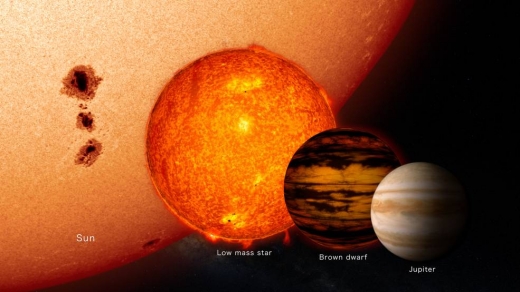
Image: This illustration shows the average brown dwarf is much smaller than our sun and low mass stars and only slightly larger than the planet Jupiter. Credits: NASA’s Goddard Space Flight Center.
Usefully, we will soon be able to test this prediction at a new level of precision. Schlaufman is saying that planets in the mass range of 1 to 10 Jupiters should preferentially be found around metal-rich solar-type dwarf stars, while brown dwarfs between 10 and 80 Jupiter masses should be found around solar-type dwarf stars that span the entire range of metallicity. The European Space Agency’s Gaia mission is expected to find and characterize 21,000 ± 6000 giant planets and brown dwarfs, a sample large enough to put Schlaufman’s theories to the test.
The paper is Schlaufman, “Evidence of an Upper Bound on the Masses of Planets and Its Implications for Giant Planet Formation,” published online by The Astrophysical Journal 22 january 2018 (abstract/preprint).

Planet Mimicry: Disk Patterns in Infant Systems
The wrong initial assumption can easily lead anyone down a blind alley. The problem comes across loud and clear in new work from Marc Kuchner (NASA GSFC) and colleagues, which Kuchner presented at the recent meeting of the American Astronomical Society in Washington. At issue is the matter of the disks of gas and dust around young stars, in many of which we can find patterns such as rings, arcs and spirals that suggest the formation of planets.
But are such patterns sure indicators or merely suggestions? Kuchner’s team has been looking at the question for several years now, presenting in a 2013 paper the possibility that a phenomenon called photoelectric instability (PeI) can explain the narrow rings we see in some disk systems. PeI happens when high-energy ultraviolet light strikes dust and ice grains, stripping away electrons. The electrons then strike and heat gas in the disk, causing gas pressure to increase and more dust to be trapped. Rings can form that begin to oscillate, along with arcs and clumps — bright, moving sources of light that could be mistaken for planets.
Photoelectric instability is a cascading phenomenon as rising gas pressure affects the orbiting dust, with clumps forming with many times the dust density found elsewhere in the disk. In the new paper, submitted to The Astrophysical Journal, Kuchner and Wladimir Lyra (California State University) worked with Penn State doctoral student Alexander Richert to factor in radiation pressure.
Photons have no mass but they do convey momentum. Conceive a dust particle as a tiny solar sail and consider how that momentum can push the dust surrounding a young star into highly eccentric orbits. The team shows that by including radiation pressure in their model, spirals like those found around the star HD 141569A, a star studied in the 2013 paper, can be created. These do not necessarily indicate a planet.
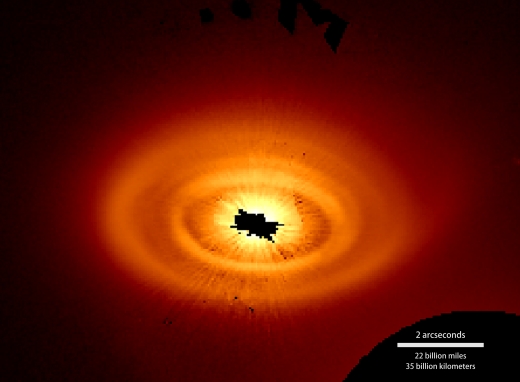
Image: Arcs, rings and spirals appear in the debris disk around the star HD 141569A. The black region in the center is caused by a mask that blocks direct light from the star. This image incorporates observations made in June and August 2015 using the Hubble Space Telescope’s STIS instrument. Credits: NASA/Hubble/Konishi et al. 2016.
“Carl Sagan used to say extraordinary claims require extraordinary evidence,” Lyra said. “I feel we are sometimes too quick to jump to the idea that the structures we see are caused by planets. That is what I consider an extraordinary claim. We need to rule out everything else before we claim that.”
We can now view some prominent disk structures with an eye toward photoelectric instability, as the paper notes:
…the non-axisymmetric clumps and spiral arms seen in the gas distributions in several of our models suggest that interactions between gas and small-to-medium grains could underlie the asymmetric structures seen in the 49 Ceti and AU Mic edge-on disks (Hughes et al. 2017; Boccaletti et al. 2015), though explanations for the AU Mic moving blobs involving only rocky body collisions (no gas) have also been proposed (Sezestre et al. 2017; Chiang & Fung 2017). We also underscore that so far the PeI is the best candidate for producing arcs, a feature that is not predicted from planet-disk interaction. That the PeI leads to arcs was predicted by Lyra & Kuchner (2013), before the discovery of these features in the disk around HD 141569A (Perrot et al. 2016).
We’ve got a long way to go in studying these phenomena, and the new paper casts a critical eye on what physical processes and parameters still need to be explored, among them turbulence and varying types of dust and gas. This roadmap of future work should be useful, particularly as we try to extend these simulations beyond stars like the Sun into the realm, for example, of A-class stars. The point is that untangling the numerous conceivable interactions in young disks is necessary before we can construct truly accurate models of planet formation.
…planet-disk interactions in optically thin disks may manifest themselves very differently than they do in existing, simpler models. The formation of gaps, rings, and other disk morphologies associated with planets may be inhibited, enhanced, or otherwise affected by the presence of gas.
Go easy on the assumptions, in other words, and tune up the modeling of infant stellar systems. What looks for all the world to be planets in formation may yet prove an earlier stage of system evolution. Run on the Discover computing cluster at NASA GSFC, the Kuchner team’s simulations are showing just how complicated the interactions in a young disk can be.
The paper is Richert et al., “The interplay between radiation pressure and the photoelectric instability in optically thin disks of gas and dust,” submitted to The Astrophysical Journal (preprint). The 2013 paper is Kuchner and Lyra, “Formation of sharp eccentric rings in debris disks with gas but without planets,” Nature 499 (11 July 2013), pp. 184-187 (abstract). Kuchner also heads up a citizen science project called Disk Detective that has produced 2.5 million classifications of potential disks.

K2-138: Multi-Planet System via Crowdsourcing
As Centauri Dreams readers know, I always keep an eye on the K2 mission, the rejuvenated Kepler effort to find exoplanets with a spacecraft that had originally examined 145,000 stars in Cygnus and Lyra. Now working with different fields of view, K2 has examined a surprisingly large number of stars, some 287,309, according to this Caltech news release. Digging around a bit, I discovered that each 80-day campaign brings in data on anywhere from 13,000 to 28,000 targets, all released to the public within three months of the end of the campaign. In the paper we’ll discuss today, this influx is referred to as a ‘deluge of data.’
Our datasets just continue to grow in a time of exploration that seems unprecedented in scientific history. I’ve heard it compared to the explosion in knowledge of microorganisms after their detection by van Leeuwenhoek in the 17th Century, though of course it also conjures up thoughts of early exploratory voyages as humans pushed into hitherto unknown terrain. But given that we are finding exoplanets in huge variety and by the thousands, this era surely has an edge because of the speed with which it is happening and its related search for life.
No wonder that public interest is high, and it’s gratifying to see projects like Exoplanet Explorers available (through the Zooniverse site) to serve as a platform for crowdsourced research. Exoplanet Explorers sifts through K2 data to look for transiting planets, with calibrated data files up through Campaign 14 (C14) and the uncalibrated data from Campaign 15 now available. The project, which went online for the first time last April, has already snagged, among other things, a highly interesting multi-planet system dubbed K2-138, and in a highly visible way.

Image: Artist’s visualization of the K2-138 system, the first multi-planet system discovered by citizen scientists. The central star is slightly smaller and cooler than our sun. The five known planets are all between the size of Earth and Neptune; planet b may potentially be rocky, but planets c, d, e, and f likely contain large amounts of ice and gas. All five planets have orbital periods shorter than 13 days and all are incredibly hot, ranging from 425 to 980 degrees Celsius. Credit: NASA/JPL-Caltech/R. Hurt (IPAC).
Potential transit signals can be spotted by computers using signal-processing algorithms, but detections can be iffy. Many features that might seem to flag a transit can turn out to be astrophysical in origin, everything from eclipsing binaries to flare stars, pulsating variables, even cosmic-ray pixel strikes. We also have to account for instrument issues like spacecraft pointing drift. All this makes human eyes on the data a sensible idea, for the human brain is optimized for pattern matching and has proven successful at distinguishing between transits and artifacts.
Exoplanet Explorers runs a signal detection algorithm first to identify potential transit signals and then asks its users to examine the resulting candidates. K2-138 is the first K2 planetary system discovered by the project, and the first multi-planet system found entirely by crowdsourcing.
To help boost interest among the public, UC-Santa Cruz astronomer Ian Crossfield and Caltech staff scientist Jessie Christiansen worked with a British TV show, in co-production with ABC Australia, called Stargazing Live. Last April they introduced Exoplanet Explorers in a three-day event. The enthusiasm for crowdsourcing exoplanet research became immediately evident, as over 2 million classifications came in from more than 10,000 users, some of them analyzing the C12 dataset, which had yet to be examined by professional astronomers.
The quickly identified planet candidates included 44 Jupiter-sized planets, 72 Neptune-sized, 44 Earth-sized, and 53 ‘Super Earths.’ Each potential transit is looked at by a minimum of 10 volunteers using the Exoplanet Explorers platform, with each needing a minimum of 90 percent positive votes to proceed to further characterization. Crossfield and Christiansen determined to look for a signal likely to be confirmed for discussion on the show’s last night.
“We wanted to find a new classification that would be exciting to announce on the final night, so we were originally combing through the planet candidates to find a planet in the habitable zone—the region around a star where liquid water could exist,” says Christiansen. “But those can take a while to validate, to make sure that it really is a real planet and not a false alarm. So, we decided to look for a multi-planet system because it’s very hard to get an accidental false signal of several planets.”
Within the crowdsourced data, Christiansen and colleagues found a star with four planets, three of the four with 100 percent ‘yes’ votes from over 10 volunteers and a fourth with 92 percent. Having announced the discovery on Stargazing Live, the scientists went to work on K2-138, determining that the four planets orbit in a resonance, and finding a fifth planet on the same chain of resonances, with some possibility of a sixth. The five planets are all sub-Neptune in size, ranging from 1.6 to 3.3 Earth radii. All have periods under 13 days, making this an example of a tightly packed system of small planets.

Image: Artist’s concept of a top-down view of the K2-138 system discovered by citizen scientists, showing the orbits and relative sizes of the five known planets. Orbital periods of the five planets, shown to scale, fall close to a series of 3:2 mean motion resonances. This indicates that the planets orbiting K2-138, which likely formed much farther away from the star, migrated inward slowly and smoothly. Credit: Credit: NASA/JPL-Caltech/R. Hurt (IPAC).
In a paper accepted at The Astronomical Journal, the scientists describe the discovery and characterization of the system, calling it:
…a compact system of five sub-Neptune sized planets orbiting an early-K star in a chain of successive near-first-order resonances; in addition, the planets are locked in a set of three-body Laplace resonances. The planets may be accessible to mass measurement via dedicated radial velocity monitoring, and possibly via TTVs with improved timing precision.
and going on to note:
The Exoplanet Explorers project has provided an additional 68 candidate planets from the C12 light curves that likely contain additional planet discoveries, and we plan to upload potential detections for consideration from the rest of the available K2 campaigns.
These may be interesting planets, as the paper notes, for atmospheric characterization. In any case, multi-planet systems are useful as laboratories for planet formation, allowing us to test models of migration and system evolution. Caltech’s Konstantin Batygin, who was not involved in the paper, points to the “…rather gentle and laminar formation environment of these distant worlds.” It’s an interesting point also echoed by Christiansen. Chaotic scattering of materials in an early planetary system seems unlikely to produce quite so orderly a configuration.
The paper is Christiansen, Crossfield et al., “The K2-138 System: A Near-resonant Chain of Five Sub-Neptune Planets Discovered by Citizen Scientists,” accepted at The Astronomical Journal (preprint).

New Titan Findings from Topographical Map
Cassini’s huge dataset will yield discoveries for many years, as witness the global topographical map of Titan that has been assembled by Cornell University astronomers. The map draws on topographical data of the moon from multiple sources by way of studying its terrain and the flow of its surface liquids. Bear in mind that only 9 percent of Titan has been observed at relatively high resolution, and another 25-30 percent at lower resolution. For the remainder, the team mapped the surface using an interpolation algorithm and a global minimization process described in the first of two papers in Geophysical Review Letters.
The methods are complex and described in detail in the paper. For our purposes, let’s look at the result:
We present updated topographic and spherical harmonic maps of Titan making use of the complete Cassini RADAR data set for use by the scientific community. These maps improve on previous efforts (Lorenz et al., 2013; Mitri et al., 2014) through their increased coverage, higher resolutions, a global minimization of the data, and incorporation of observational errors, with the intent to serve a broader range of studies within the Titan community.
What stands out here are new mountains, none of them higher than 700 meters, and a global view of Titan’s topography that confirms that two locations in the equatorial region are depressions, a sign of cryovolcanic flows or, perhaps, ancient, now dried seas. There is also an implication that Titan’s crust may be more variable in thickness than previously believed, for the map shows a flatter (more oblate) Titan than our view up until now has suggested.
Three significant results emerge in the second of the two papers. We learn that Titan’s three seas share a common equipotential surface; i.e., a sea level. Although Titan’s seas are filled with hydrocarbons instead of water and are surrounded with a water ice bedrock, they do, just like Earth’s oceans, follow a constant elevation relative to Titan’s gravitational pull. Put another way, the oceans on Titan are all at the same elevation, the result of either flow through the subsurface between them or actual channels between the seas allowing liquid flow.
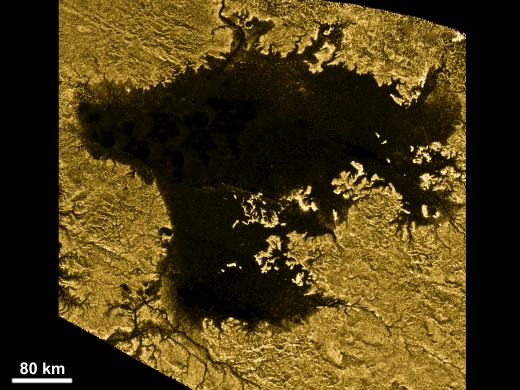
Image: Ligeia Mare, shown here in a false-color image from NASA’s Cassini mission, is the second largest known body of liquid on Saturn’s moon Titan. It is filled with liquid hydrocarbons, such as ethane and methane, and is one of the many seas and lakes that bejewel Titan’s north polar region. Credit: NASA/JPL-Caltech/ASI/Cornell.
Here’s Cornell’s Alex Hayes, senior author on the paper, describing the finding:
“We’re measuring the elevation of a liquid surface on another body 10 astronomical units away from the sun to an accuracy of roughly 40 centimeters. Because we have such amazing accuracy we were able to see that between these two seas the elevation varied smoothly about 11 meters, relative to the center of mass of Titan, consistent with the expected change in the gravitational potential. We are measuring Titan’s geoid. This is the shape that the surface would take under the influence of gravity and rotation alone, which is the same shape that dominates Earth’s oceans.”
Thus the seas form a sea level, although, again like Earth, smaller lakes can appear at elevations several hundred meters higher than Titan’s sea level — this suggests that the lakes are isolated from the seas. There is also evidence in the topographical work that Titan’s lakes within a given ‘watershed’ communicate with each other through the subsurface. The floors of empty lakes are all at higher elevations within a watershed than any nearby filled lakes. No empty lakes are found below nearby filled lakes because they would then fill. An active flow has to be at work here in the form of liquid hydrocarbons below the surface.
From the paper:
Formation cannot involve significant fluvial processes unless the widths of the resulting channels and/or valleys remain smaller than the ~300 m resolution of the Cassini RADAR. Regardless, fluvial channels cannot be the dominant method for removing material from the basin. Within a regional topographic basin, the lakes appear dynamically linked such that their fill state is determined by the elevation of their basin floors as compared to the local phreatic surface or impermeable boundary.
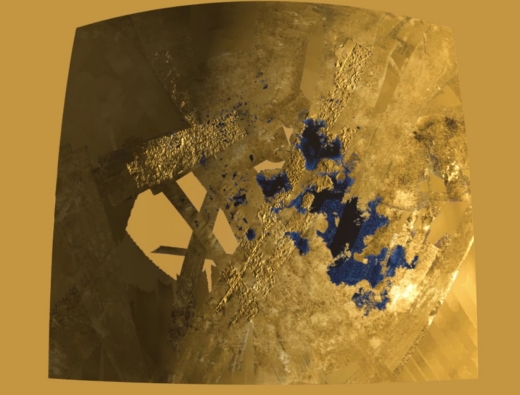
Image: This frame from a colorized flyover movie from NASA’s Cassini mission shows the two largest seas on Saturn’s moon Titan and nearby lakes. The liquid in Titan’s lakes and seas is mostly methane and ethane. Credit: NASA/JPL-Caltech/ASI/USGS.
Titan’s lakes, concentrated in the polar regions, prove to be curiosities. Most of them are in depressions with sharp edges that, says Hayes, “literally look like you took a cookie cutter and cut out holes in Titan’s surface.” The ridges surrounding the lakes can be hundreds of meters high in some areas, making the lakes topographically closed; they stand out starkly from the surrounding undulating plains. Understanding the process that shapes these lakes and their sharply defined edges will be key to making sense of the evolution of the polar basins on Titan.
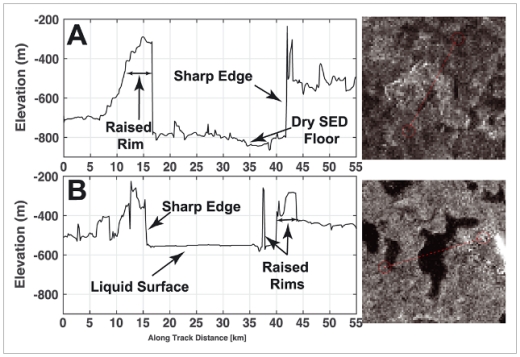
Image: This is Figure 1 from the “Topographic Constraints on the Evolution and Connectivity of Titan’s Lacustrine Basins” paper. Caption: Closest-approach altimetry profiles an unfilled and filled SED observed in (a) May 2007 (T30) and (b) April 2017 (T126), respectively. The profiles were processed to improve along-track resolution using the delay-Doppler algorithm described in Michaelides et al. (2016). Note that raised rims border the steep-sided depressions in both the empty and filled SEDs. Credit: Hayes et al.
The sharp-edged depressions, referred to in the paper as SEDs, are a unique feature of Titan, as the second of the two papers on the topographical map makes clear:
SEDs include the majority of Titan’s smaller lakes and are morphologically distinct from the larger, broad depressions (Hayes, 2016). The morphologic similarities between filled and empty SEDs have been used to suggest that dry SEDs represent previously filled, but now empty, lakes (Hayes et al., 2008). The spatial ubiquity and distinct morphologic expression of the SEDs make them a distinctive landform of Titan’s polar terrain (e.g., Aharonson et al., 2014).
First author Paul Corlies, a Cornell doctoral student, says that the data set aroused immediate interest among scientists, with the first inquiries about its use coming in within 30 minutes of the data being made available online. Out of this should come useful tweaks to our current models of Titan’s climate, as well as new work on interior models and studies of the moon’s gravity.
The papers are Corlies et al., “Titan’s Topography and Shape at the End of the Cassini Mission,” published online at Geophysical Research Letters 2 December 2017 (full text); and Hayes et al., “Topographic Constraints on the Evolution and Connectivity of Titan’s Lacustrine Basins,” published online at Geophysical Research Letters 2 December 2017 (full text).

Substellar Objects in Orion
Although I carry on about upcoming observatories on the ground and in space, I never want to ignore the continuing contribution of the Hubble telescope to our understanding of planet and star formation. As witness the latest deep survey made by team lead Massimo Robberto (Space Telescope Institute) and colleagues, which used the instrument to study small, faint objects in the Orion Nebula. At a relatively close 1,350 light years from Sol, the nebula is something of a proving ground for star formation, and now one that is yielding data on small stars indeed.
Identifying some 1,200 candidate reddish stars, the survey tapped Hubble’s infrared capabilities to extract 17 candidate brown dwarf companions to red dwarf stars, one brown dwarf pair and one brown dwarf with a planetary companion. We also learn that a planetary mass companion to a red dwarf has turned up as well as, interestingly enough, a planet-mass companion to another planet, the duo orbiting each other in the absence of a central star.
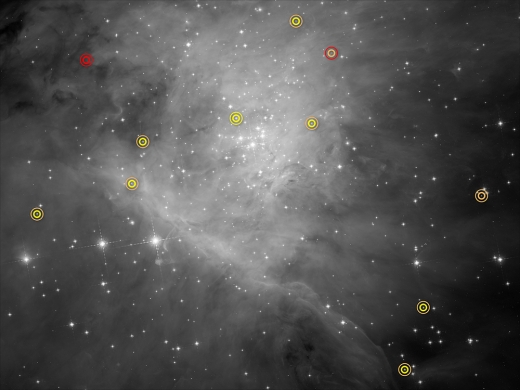
Image: This image is part of a Hubble Space Telescope survey for low-mass stars, brown dwarfs, and planets in the Orion Nebula. Each symbol identifies a pair of objects, which can be seen in the symbol’s center as a single dot of light. Special image processing techniques were used to separate the starlight into a pair of objects. The thicker inner circle represents the primary body, and the thinner outer circle indicates the companion. The circles are color-coded: Red for a planet; orange for a brown dwarf; and yellow for a star. Located in the upper left corner is a planet-planet pair in the absence of a parent star. In the middle of the right side is a pair of brown dwarfs. The portion of the Orion Nebula measures roughly 4 by 3 light-years. Credit: NASA , ESA, and G. Strampelli (STScI).
How to separate brown dwarf candidates from small red dwarfs? The technique in play was identification of water vapor in their atmospheres, which can peg cool red dwarfs as well, according to this Space Telescope Science Institute news release:
“These are so cold that water vapor forms,” explained Robberto. “Water is a signature of substellar objects. It’s an amazing and very clear mark. As the masses get smaller, the stars become redder and fainter, and you need to view them in the infrared. And in infrared light, the most prominent feature is water.”
The free-floating brown dwarfs and planets within the Orion Nebula are all new discoveries, a tribute to Hubble’s continuing role in astrophysical discovery. The search for binary companions to the 1,200 candidate stars in the original sample relied on high-contrast imaging techniques developed at STScI by Laurent Pueyo. The presence of water vapor in the atmospheres of the candidate companions is evidence that they are not the result of a chance alignment with background stars but rather must be brown dwarfs or exoplanet companions. Says Pueyo:
“We experimented with a method, high-contrast imaging post processing, that astronomers have been relying on for years. We usually use it to look for very faint planets in the close vicinity of nearby stars, by painstakingly observing them one by one. This time around, we decided to combine our algorithms with the ultra-stability of Hubble to inspect the vicinity of hundreds of very young stars in every single exposure obtained by the Orion survey. It turns out that even if we do not reach the deepest sensitivity for a single star, the sheer volume of our sample allowed us to obtain an unprecedented statistical snapshot of young exoplanets and brown dwarf companions in Orion.”
What other discoveries are waiting to be made in the Hubble archive? That data trove is soon to be complemented with the launch of the James Webb Space Telescope next year, an observatory designed to operate at infrared wavelengths.
Meanwhile, we have an early sample of low-mass objects early in the formation process, some of them solitary stars or brown dwarfs, others companions to other objects. Watching the formation process here may provide helpful insights into the boundary between star and planet as they evolve in such stellar nurseries.


